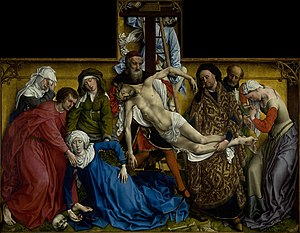


The Swoon of the Virgin, in Italian Lo Spasimo della Vergine, or Fainting Virgin Mary was an idea developed in the late Middle Ages, that the Virgin Mary had fainted during the Passion of Christ, most often placed while she watched the Crucifixion of Jesus. It was based on mentions in later texts of the apocryphal Gospel of Nicodemus (Acta Pilati), which describe Mary swooning. It was popular in later medieval art and theological literature, but as it was not mentioned in the Canonical Gospels, it became controversial - Protestants rejecting it outright, and from the 16th century discouraged also by many senior Catholic churchmen.
The swoon might be placed during the episode of Christ Carrying the Cross, as on the Via Dolorosa in Jerusalem, but very commonly also during the Crucifixion of Jesus; Nicholas Penny estimates that "about half of the surviving paintings of the Crucifixion made between 1300 and 1500 will be found to include the Virgin fainting".[2] It also appeared in works showing the Deposition from the Cross and Entombment of Christ,[3] as well as the 15th-century novelty of Christ taking leave of his Mother.
- ^ A copy in oils of this fresco of 1556
- ^ Penny, 26
- ^ Penny, 28